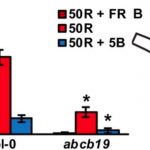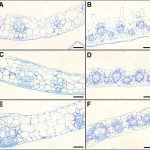On the Inside: Non-Stomatal Water Loss by Tomato Fruits
 In land plants, water is lost primarily by transpiration through stomata. However, when the aerial tissues begin to dry, the stomata close, and transpiration, much reduced, occurs mostly from the apoplast of epidermal cells. The hydrophobic cuticle that coats the epidermis of aerial organs provides the key barrier against this flux. Despite extensive research, however, the key factors that determine the permeances of cuticles, which vary by over 500-fold across plant species, have not been fully resolved. Despite the substantial effect of waxes, there does not appear to be a correlation between total wax levels and cuticular permeance across, or within, species. Some have hypothesized that the wax compositional profile, rather than amount, is likely to be the key determinant of cuticular permeance. An alternative hypothesis is that there exist pores that span the cuticle and provide a lower resistance route for water movement and largely dictate water flux. Tomato (Solanum lycopersicum) provides an excellent system in which to study non-stomatal water loss because its fruits are astomatous. Fich et al. (10.1104/pp.20.01105) screened 398 tomato accessions from around the world and selected seven cultivars that collectively exhibited the lowest and highest degrees of transpirational water loss for more detailed study. The transpirational differences between these lines reflected the permeances of their isolated cuticles, but this did not correlate with various measures of cuticle abundance or composition. Rather, the fruit cuticle permeance was strongly dependent on the abundance of microscopic, transcuticular pores that are associated with trichomes and are exposed when the trichomes are dislodged. During post-harvest storage, limited self-sealing of the pores was detected for certain cultivars. The abundance of trichome-associated pores, together with their self-sealing capacity, presents a promising target for breeding or engineering efforts aimed at reducing fruit transpirational water loss.
In land plants, water is lost primarily by transpiration through stomata. However, when the aerial tissues begin to dry, the stomata close, and transpiration, much reduced, occurs mostly from the apoplast of epidermal cells. The hydrophobic cuticle that coats the epidermis of aerial organs provides the key barrier against this flux. Despite extensive research, however, the key factors that determine the permeances of cuticles, which vary by over 500-fold across plant species, have not been fully resolved. Despite the substantial effect of waxes, there does not appear to be a correlation between total wax levels and cuticular permeance across, or within, species. Some have hypothesized that the wax compositional profile, rather than amount, is likely to be the key determinant of cuticular permeance. An alternative hypothesis is that there exist pores that span the cuticle and provide a lower resistance route for water movement and largely dictate water flux. Tomato (Solanum lycopersicum) provides an excellent system in which to study non-stomatal water loss because its fruits are astomatous. Fich et al. (10.1104/pp.20.01105) screened 398 tomato accessions from around the world and selected seven cultivars that collectively exhibited the lowest and highest degrees of transpirational water loss for more detailed study. The transpirational differences between these lines reflected the permeances of their isolated cuticles, but this did not correlate with various measures of cuticle abundance or composition. Rather, the fruit cuticle permeance was strongly dependent on the abundance of microscopic, transcuticular pores that are associated with trichomes and are exposed when the trichomes are dislodged. During post-harvest storage, limited self-sealing of the pores was detected for certain cultivars. The abundance of trichome-associated pores, together with their self-sealing capacity, presents a promising target for breeding or engineering efforts aimed at reducing fruit transpirational water loss.



